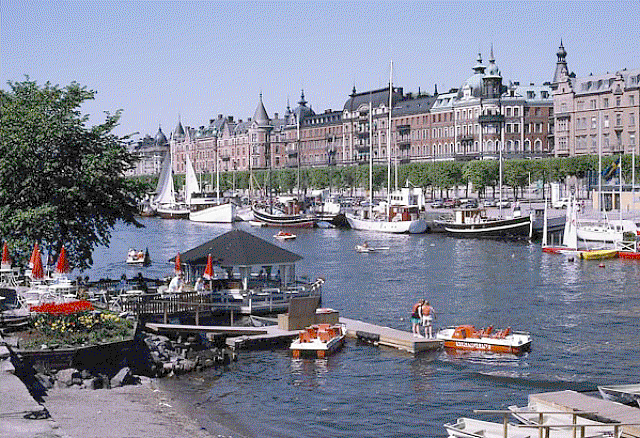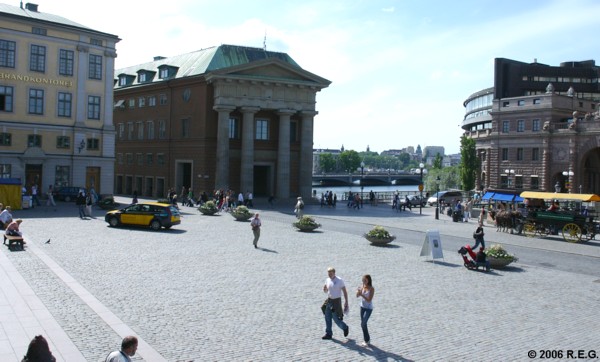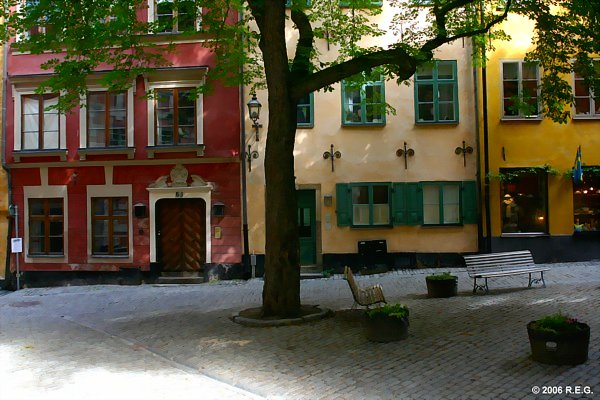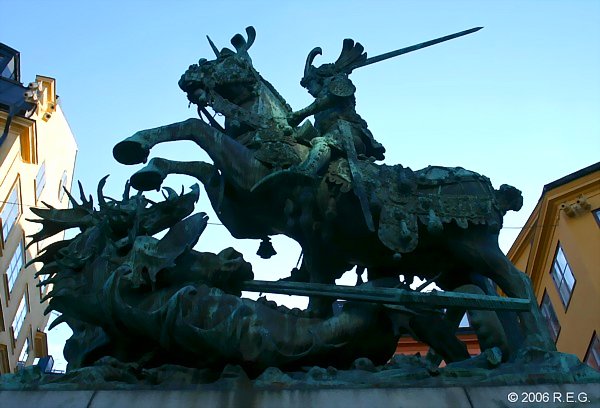The Table of Content


Family Research:






 

Available Help:



|

Strandvagen
Stockholm (Swedish pronunciation: stock'olm) is the capital and the largest city of Sweden. It is the site of the Swedish government, the Riksdag (parliament)and the official residence of the Swedish monarch as well as the prime minister. Since 1980, the monarch has resided at Drottningholm Palace outside of Stockholm and uses the Royal Palace of Stockholm as his workplace and official residence. As of 2009, the Stockholm metropolitan area is home to approximately 22% of Sweden's population, and contributes 28% of Sweden's gross domestic product. Stockholm is the most populous city in Sweden with a population of 825,057 in the municipality (2009), 1.25 million in the urban area (2005), and 2 million in the metropolitan area (2009).
Founded circa 1250, Stockholm has long been one of Sweden's cultural, media, political and economic centers. Its strategic location on 14 islands on the south-central east coast of Sweden at the mouth of Lake Mälaren, by the Stockholm archipelago, has been historically important. Stockholm has been nominated by GaWC as a global city, with a ranking of Alpha-. In The 2008 Global Cities Index, Stockholm ranked 24th in the world, 10th in Europe and first in Scandinavia. Stockholm is known for its beauty, its buildings and architecture, its abundant open water and many parks. It is sometimes referred to as the Venice of the North. Stockholm is the second most visited city in the Nordic countries, with around one million visitors in 2006.
History
Stockholm's location appears in Norse sagas as Agnafit, and in Heimskringla in connection with the legendary King Agne. The earliest written mention of the name Stockholm dates from 1252, by which time the mines in Bergslagen made it an important site in the iron trade. The first part of the name (stock) means log in Swedish, although it may also be connected to an old German word (Stock), meaning fortification. The second part of the name (holm) means islet, and is thought to refer to the islet Helgeandsholmen in central Stockholm. The city is said to have been founded by Birger Jarl to protect Sweden from a sea invasion by foreign navies, and to stop the pillage of towns such as Sigtuna on Lake Mälaren.
Stockholm's core, the present Old Town, Gamla stan, was built on the central island next to Helgeandsholmen from the mid-13th century onward. The city originally rose to prominence as a result of the Baltic trade of the Hanseatic League. Stockholm developed strong economic and cultural linkages with Lübeck, Hamburg, Gdańsk, Visby, Reval and Riga during this time between 1296 and 1478 Stockholm's City Council was made up of 24 members, half of whom were selected from the town's German-speaking burghers.
The strategic and economic importance of the city made Stockholm an important factor in relations between the Danish Kings of the Kalmar Union and the national independence movement in the 15th century. The Danish King Christian II was able to enter the city in 1520. On November 8, 1520, a massacre of opposition figures, called the "Stockholm Bloodbath", took place and set off further uprisings that eventually led to the breakup of the Kalmar Union. With the accession of Gustav Vasa in 1523 and the establishment of a royal power, the population of Stockholm began to grow, reaching 10,000 by 1600.
The 17th century saw Sweden grow into a major European power, reflected in the development of the city of Stockholm. From 1610 to 1680, the population multiplied six fold. In 1634, Stockholm became the official capital of the Swedish empire. Trading rules were also created that gave Stockholm an essential monopoly over trade between foreign merchants and other Swedish and Scandinavian territories.
In 1710 the Black Death reached Stockholm. After the end of the Great Northern War the city stagnated. Population growth halted and economic growth slowed. The city was in shock after having lost it's place as the capital of a Great Power. However, Stockholm maintained its role as the political center of Sweden and continued to develop culturally under Gustav III. The royal opera is a good architectural example of this era.
By the second half of the 19th century, Stockholm had regained its leading economic role. New industries emerged, and Stockholm transformed into an important trade and service center, as well as a key gateway point within Sweden. The population also grew radically during this time, mainly through immigration. At the end of the century, less than 40% of the residents were Stockholm-born. Settlement began to expand outside of the city limits. In the 19th century, a number of scientific institutes opened in Stockholm, including the Karolinska Institute and the General Art and Industrial Exposition was held in 1897.
During the latter half of the 20th century, Stockholm became a modern, technologically advanced, and ethnically diverse city. Many historical buildings were torn down, including the entire historical district of Klara, and replaced with modern architecture. Throughout the century, many industries shifted away from work-intensive activities into more high-technology and service-industry areas.
The city continued to expand and new districts were created, such as Rinkeby, and Tensta, some with high proportions of immigrants.
Climate
Despite its location, Stockholm has relatively mild temperatures. The city enjoys 1,981 hours of sunshine annually.
Summers are warm and pleasant with average daytime high temperatures of 20–22 °C (68–72 °F) and lows of around 13 °C (55 °F), but temperatures frequently exceed 25 °C (77 °F). Winters are cold with average temperatures ranging from −5 to 1 °C (23 to 34 °F), and rarely drop below −15 °C (5.0 °F). Spring and autumn are generally cool to mild.
The highest temperature ever recorded in Stockholm was 36 °C (97 °F); the lowest was −32 °C (−25.6 °F).
Annual precipitation is 539 mm (21.2 in) with around 170 wet days and light to moderate rainfall throughout the year. Snow mainly occurs from December through March.
Annual precipitation is 539 mm (21.2 in) with around 170 wet days and light to moderate rainfall throughout the year. Snow mainly occurs from December through March.
Politics and Government
Municipalities are responsible for government-mandated duties, and elections for the municipal council are held every four years, parallel to the general elections.
Following the 2006 municipal elections, the seats were divided in the following way: | The Governing Parties | | Parties in Opposition | | Moderate Party 41 | | Social Democrats 27 | | Liberal People's Party 10 | | Left Party 9 | | Christian Democrats 3 | | Green Party 10 | | Centre Party 1 | | |
Demographics
The Stockholm region is home to around 22% of Sweden's total population, and accounts for about 28% of the gross domestic product. The geographical notion of "Stockholm" has changed throughout the times. By the turn of the 19th century, Stockholm basically consisted of the area today known as City Centre, roughly 35 sq km (14 sq mi) or 1/5 of the current municipal area. In the ensuing decades several other areas were incorporated (such as in 1913, at which time it had 25,000 inhabitants, and Spånga in 1949). The municipal border was established in 1971 – with the exception of Hansta, in 1982 purchased by Stockholm Municipality from Sollentuna Municipality and today a nature reserve.
Of the population of 765,044 in 2004, 370,482 were men and 394,562 women. The average age is 39.8 years; 40.5% of the population is between 20 and 44 years. 309,480 people, or 40.4% of the population, over the age 15 were unmarried. 211,115 people, or 27.5% of the population, were married. 85,373, or 11.1% of the population, had been married but divorced. 28% of residents have immigrant or minority heritage and background. Residents of Stockholm are known as Stockholmers. Some of the suburbs have large populations of immigrants. Some languages spoken in Greater Stockholm beside Swedish and English due to large numbers of immigrants are Bosnian, Syria, Arabic, Turkish, Kurdish, Finnish, Persian, Spanish, Serbian and Croatian.
In the last century, the population of nearby municipalities in Stockholm County has become relevant to mention as well as the population of Stockholm Municipality, as many municipalities form part of the Stockholm urban area and as such are often considered part of the general term "Stockholm".
As of 2005, Stockholm urban area has a population of 1,252,020; Huddinge 90,182; Järfälla 62,342; Solna 61,717; Sollentuna 60,528; Botkyrka 77,553; Haninge 72,956; Tyresö 41,476; Sundbyberg 33,868; Nacka 82,421; Danderyd 30,492). In the entire Stockholm metropolitan, with its 26 municipalities, the population reaches more than 2 million inhabitants.
Culture
Apart from being a large city with an active cultural life, Stockholm, as Sweden's capital, houses many national cultural institutions. There are two UNESCO World Heritage sites in the Stockholm area: the Royal Palace Apart from being a large city with an active cultural life, Stockholm, as Sweden's capital, houses many national cultural institutions. There are two UNESCO World Heritage sites in the Stockholm area: the Royal Palace Drottningholm (within Ekerö Municipality) and the Skogskyrkogården (The Woodland Cemetery).
Stockholm was the 1998 European City of Culture.
Literature
Authors connected to Stockholm include the poet and songwriter Authors connected to Stockholm include the poet and songwriter Carl Michael Bellman (1740–1795), novelist and dramatist August Strindberg (1849–1912).
Architecture
The city's oldest section is Gamla Stan (Old Town), located on the original small islands of the city's earliest settlements and still featuring the medieval street layout. Some notable buildings of Gamla Stan are the large German Church (Tyska kyrkan) and several mansions and palaces: the Riddarhuset (the House of Nobility), the Bonde Palace, the Tessin Palace and the Oxenstierna Palace. The oldest building in Stockholm is the Riddarholmskyrkan from the late 13th century. After a fire in 1697 when the original medieval castle was destroyed, Stockholm Palace was erected in a baroque style. Storkyrkan Cathedral, the Episcopal seat of the Bishop of Stockholm, stands next to the castle. It was founded in the 13th century but is clad in a baroque exterior dating to the 18th century.
Stockholm's Gamla Stan



As early as the 15th century, the city had expanded outside of its original borders. Some pre-industrial, small-scale buildings from this era can still be found in Södermalm. During the 19th century and the age of industrialization Stockholm grew rapidly, with plans and architecture inspired by the large cities of the continent such as Berlin and Vienna. Notable works of this time period include public buildings such as the Royal Swedish Opera and private developments such as the luxury housing developments on Strandvägen.
In the 20th century, a nationalistic push spurred a new architectural style inspired by medieval and renaissance ancestry as well as influences of the Jugend / Art Nouveau style. A key landmark of Stockholm, the Stockholm City Hall , was erected 1911-1923 by architect Ragnar Östberg. Other notable works of these times are the Stockholm Public Library and the Forest Cemetery, Skogskyrkogården.
In the 1930s modernism characterized the development of the city as it grew. New residential areas sprang up such as the development on Gärdet while industrial development added to the growth, such as the KF manufacturing industries on Kvarnholmen located in the Nacka Municipality. In the 1950s, suburban development entered a new phase with the introduction of the Stockholm metro. The modernist developments of Vällingby and Farsta were internationally praised. In the 1960s this suburban development continued but with the aesthetic of the times, the industrialized and mass-produced blocks of flats received a large amount of criticism.
At the same time that this suburban development was taking place, the most central areas of the inner city were being redesigned, known as Norrmalmsregleringen. Sergels Torg , with its five high-rise office towers was created in the 1960s, followed by the total clearance of large areas to make room for new development projects. The most notable buildings from this period is the ensemble of the House of Culture, City Theatre and National Bank at Sergels Torg, designed by architect Peter Celsing.
Museums
Stockholm is one of the most crowded museum-cities in the world with around 100 museums, visited by millions of people every year. The most renowned national museum is the Nationalmuseum , with Sweden's largest collection of art: 16,000 paintings and 30,000 objects of art handicraft. The collection dates back to the days of Gustav Vasa in the 16th century, and has since been expanded with works by artists such as Rembrandt, and Antoine Watteau, as well as constituting a main part of Sweden's art heritage, manifested in the works of Alexander Roslin, Anders Zorn, Johan Tobias Sergel, Carl Larsson, Carl Fredrik Hill and Ernst Josephson.
The Museum of Modern Art, or Moderna Museet, is Sweden's national museum of modern art. It has works by famous modern artists such as Picasso and Salvador Dalí
Other notable museums:
• Stockholm City Museum
• Skansen, the archetype of open museums, inaugurated 1891.
• Nordic Museum, dedicated to the cultural history and ethnography of Sweden.
• Royal Coin Cabinet, dedicated to the history of money. The Vasa Museum, now with the reconstruction of the missing parts of the Vasa Ship.
International rankings
Stockholm often performs well in international rankings, some of which are mentioned below:
• In the book The Ultimate Guide to International Marathons (1997), written by Dennis Craythorn and Rich Hanna, Stockholm Marathon is ranked as the best marathon in the world.
• In a 2002 report by the Robert Huggins Associates which compared ninety of the world's largest economic cities and regions, Stockholm was ranked twenty-second in terms of transforming knowledge into business. Stockholm was ranked first of any city outside the United States. Major cities that ranked below Stockholm included New York, London, Tokyo, Hamburg and Hong Kong.
• In the 2006 European Innovation Scoreboard, prepared by the Maastricht Economic Research Institute on Innovation and Technology (MERIT) and the Joint Research Centre's Institute for the Protection and the Security of the Citizen of the European Commission, Stockholm was ranked as the most innovative city in Europe.
• In the 2008 World Knowledge Competitiveness Index, published by the Centre for International Competitiveness, Stockholm was ranked as the sixth most competitive region in the world and the most competitive region outside the United States.
• In the 2006 European Regional Growth Index (E-REGI), published by Jones Lang LaSalle, Stockholm was ranked fifth on the list of European cities with the strongest GDP growth forecast. Stockholm was ranked first in Scandinavia and second outside Central and Eastern Europe.
• In a 2008 survey published by the Reader's Digest magazine, Stockholm was ranked fourth in the world and first in Europe on its list of the "world’s top ten honest cities".
• In the 2007 European Cities Monitor, published by Cushman & Wakefield, Stockholm was ranked as the best Nordic city to locate a business. In the same report, Stockholm was ranked first in Europe in terms of freedom from pollution
• In a 2007 survey performed by the environmental economist Matthew Kahn for the Reader's Digest magazine, Stockholm was ranked first on its list of the "greenest" and most "livable" cites in the world.
• In a 2008 survey published by the National Geographic Traveler magazine, Gamla stan (the old town) in Stockholm was ranked sixth on its list of rated historic places.
• In a 2008 survey published by the Foreign Policy magazine, Stockholm was ranked twenty-fourth on its list of the world's most global cities.
  
|









